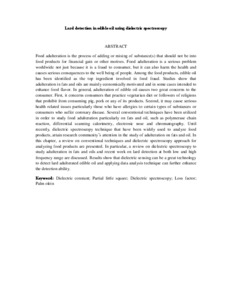Citation
Amat Sairin, Masyitah and Abd Aziz, Samsuzana and Ahmad Nizar, Nina Naquiah and Abdul Latiff, Nurul Adilah and Ismail, Alyani and Mat Hashim, Dzulkifly and Rokhani, Fakhrul Zaman
(2017)
Lard detection in edible oil using dielectric spectroscopy.
In:
Sensors for Everyday Life: Environmental and Food Engineering.
Springer International Publishing, Cham, Switzerland, pp. 245-271.
ISBN 9783319473215
Abstract
Food adulteration is the process of adding or mixing of substance(s) that should not be into food products for financial gain or other motives. Food adulteration is a serious problem worldwide not just because it is a fraud to consumer, but it can also harm the health and causes serious consequences to the well being of people. Among the food products, edible oil has been identified as the top ingredient involved in food fraud. Studies show that adulteration in fats and oils are mainly economically motivated and in some cases intended to enhance food flavor. In general, adulteration of edible oil causes two great concerns to the consumer. First, it concerns consumers that practice vegetarian diet or followers of religions that prohibit from consuming pig, pork or any of its products. Second, it may cause serious health related issues particularly those who have allergies to certain types of substances or consumers who suffer coronary disease. Several conventional techniques have been utilized in order to study food adulteration particularly on fats and oil, such as polymerase chain reaction, differential scanning calorimetry, electronic nose and chromatography. Until recently, dielectric spectroscopy technique that have been widely used to analyze food products, attain research community’s attention in the study of adulteration on fats and oil. In this chapter, a review on conventional techniques and dielectric spectroscopy approach for analyzing food products are presented. In particular, a review on dielectric spectroscopy to study adulteration in fats and oils and recent work on lard detection at both low and high frequency range are discussed. Results show that dielectric sensing can be a great technology to detect lard adulterated edible oil and applying data analysis technique can further enhance the detection ability.
Download File
![[img]](http://psasir.upm.edu.my/63770/1.hassmallThumbnailVersion/Lard%20Detection%20in%20Edible%20Oil%20Using%20Dielectric%20Spectroscopy.pdf)  Preview |
|
Text (Abstract)
Lard Detection in Edible Oil Using Dielectric Spectroscopy.pdf
Download (48kB)
| Preview
|
|
Additional Metadata
Actions (login required)
 |
View Item |

